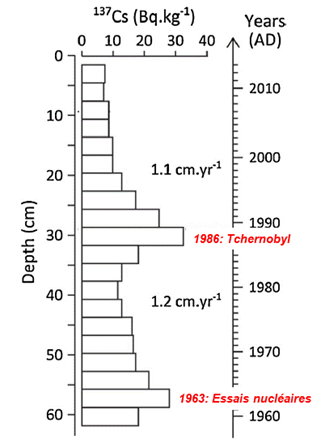Samples

All type of solid or liquid sample can be analysed, as long as one can make it fit with one of the available sample geometries.
Application
Analysis of radionuclides can be useful in the following cases:
- Dating
- Source & process tracing
- Environmental monitoring
- Materials & food survey
Application example
Determining sedimentation speed in lacustrine environment using 137Cs et 210Pb
How does it work ?
137Cs is an artificial radionuclide that has been spread in the environment after nuclear tests and nuclear incidents such as Tchernobyl and Fukushima. Within the sediment core presented hereafter, two distinct peaks of 137Cs can be identified. The first one (30 cm depth) could be attributed to the Tchernobyl incident (1986). The second one (57cm depth) could be attributed to north African atmospherical nuclear tests (1963). These two event allow then to date the sediment.
210Pb is a natural radionuclide that belongs to the 238U desintegration chain. It is carried by particles and is deposited continuously at the surface of the sediment. Measuring 210Pb radioactive decay along the sediment core depth provides then an estimate of accumulation rate. In this example, 210Pb data allow to confirm the informations provided by 137Cs data.

